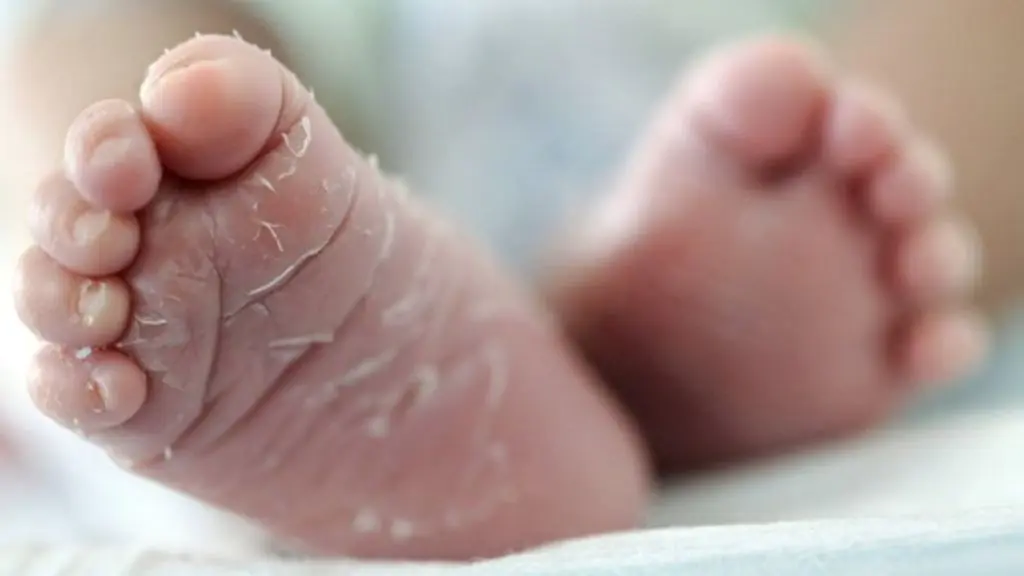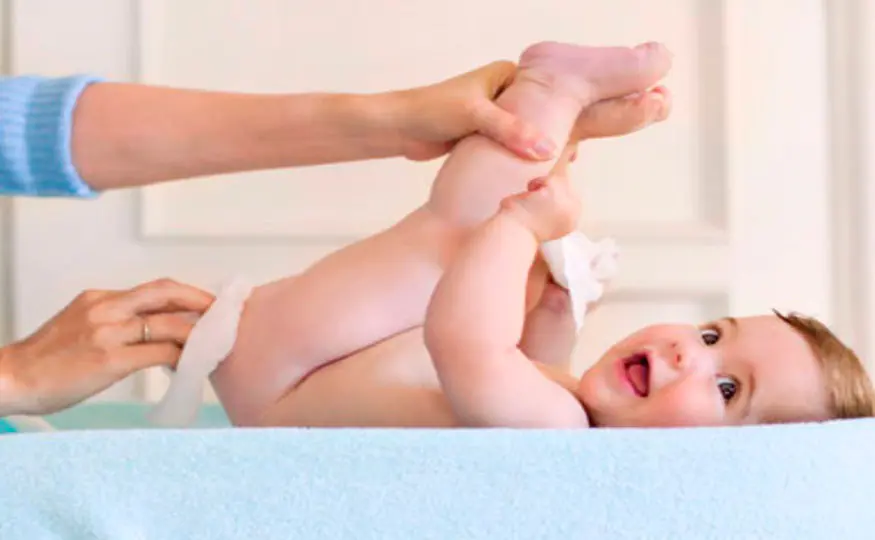All iLive content is reviewed by medical experts to ensure it is as accurate and factual as possible.
We have strict sourcing guidelines and only link to reputable sites, academic research institutions and, where possible, proven medical research. Please note that the numbers in parentheses ([1], [2], etc.) are clickable links to such studies.
If you believe that any of our content is inaccurate, out of date, or otherwise questionable, please select it and press Ctrl + Enter.
To compliment a woman and emphasize her blooming appearance they say: “You have skin like a baby!” Elastic, smooth, velvety, pink - this is what children's skin most often looks like. But they are not born like that at all. Wrinkling, cyanosis, dry skin in a newborn is a typical picture that accompanies the birth of a person. Rough and dry skin on the palms, feet, tummy, and chest worries parents; they wonder if this is normal? In the first days of a child's life, the sweat glands are not fully active and are not able to cope with sufficient hydration, which leads to dry skin. Still, such problems are temporary and in a few days everything should return to normal. If this does not happen, you need to figure out what is wrong.
ICD-10 code
Epidemiology
Dry skin, including atopic dermatitis, affects half of the population of our planet, including newborn children. And such a hereditary disease as ichthyosis affects 1 person in several tens of thousands of people.
[1], [2], [3], [4]
Causes of dry skin in a newborn
The skin of newborns is very delicate and sensitive, so it instantly reacts to any unfavorable changes in the external environment and the condition of the internal organs. The causes of dry skin in a newborn may be the following:
- dry air in the room where the child is;
- use of low-quality and age-inappropriate hygiene products: soaps, shampoos, creams;
- excessively wrapping the child;
- the use of clothes and diapers made of synthetic fabrics;
- intestinal pathology;
- hereditary disease ichthyosis;
- atopic dermatitis;
- lack of retinol and vitamin PP - the most important substance involved in the metabolic processes of the body.
[5], [6]
Risk factors
Risk factors for the appearance of dry skin in a newborn include poor nutrition of a pregnant woman, early artificial feeding or supplementary feeding, the presence of chemicals near the child or toys made from chemical materials, metabolic disorders, colds and viral diseases, and hereditary factors.
[7], [8], [9], [10]
Pathogenesis
The human skin is the largest organ in area and it performs numerous functions: respiratory, metabolic, thermoregulation, protection from an aggressive environment. Its outer stratum corneum, the epidermis, contains only 20% of the body's total water. As soon as, for one reason or another, the water evaporates, the lower layers of the skin, which, unlike the epidermis, consist of living cells, begin to give up their own, which leads to disturbances in metabolic processes, the penetration of various infections, and the occurrence of pathological conditions. The baby in the womb was immersed in amniotic fluid for 9 months, which means it was in 100% humidity. With the cutting of the umbilical cord, a radical restructuring of the entire life system occurs. A dry and one-third less humid external environment and an inability to thermoregulate are real stress for the skin of a little person. But gradually adaptation to new living conditions occurs, all processes return to normal.
[11], [12], [13], [14], [15]
Symptoms of dry skin in a newborn
In the first month of a baby's life, dry skin is quite normal. But what are the symptoms of dry skin in a newborn? The first signs are peeling of the skin of the palms, feet, dry skin of the tummy. Parents should try to create the proper microclimate in the room where the little one lives and follow all the rules for caring for him.
Very dry skin in a newborn
It may be a response to a too hot room or excessive wrapping of the child. Despite weak thermoregulation, low humidity and high air temperature will only cause dry skin and flaking in a newborn. During the period of swaddling, it is necessary to take air baths for at least two minutes, bathe in warm water every day, without adding potassium permanganate, because It dries the skin very much, use a humidifier, do not turn on the air conditioner. If everything is fine with this, but the newborn still has dry and flaky skin, you need to check the clothes and diapers in which the baby is wrapped. It is quite possible that they are made of synthetic materials, or that the seams rub against the baby’s delicate body (in children’s clothes the seams are on the front side). It is quite possible that washing detergents are not suitable; they must be special ones that do not contain chemical components. Diapers should be changed every 4 hours and immediately after bowel movements. After removing it, it is recommended to wash or wipe the child with damp cotton pads and allow him to take air baths for a few minutes. It is also necessary to take special cosmetics for moisturizing.
Dry skin on the face of a newborn
Most often, the reaction is to an incorrect diet for a nursing mother or an unsuitable formula for infants. It is necessary to analyze what could cause such a reaction and exclude the product from the menu. If the newborn has dry skin on his forehead, it is possible that the wrong baby soap or other detergent is being used. These products should not contain allergenic fragrances and they should not be used every day, except for washing the groin area. It is enough to use once a week to wash your hair, twice for your body. The baby's face requires special care: with a cotton pad soaked in boiled water, first wipe the eyes, cheeks, then the nose and lips, ending with the chin. Change the disk and repeat the procedure. Before bathing, the scalp is lubricated with Vaseline or vegetable oil due to the natural formation of flaky crusts in the parietal part. They get wet in water and are easily washed off.
[16]
Newborn has dry skin on legs
In the first days of life, a newborn has dry skin on his legs - a consequence of intrauterine lubrication, which exists for better passage of the birth canal. It is absorbed within a few days, helping to go through the adaptation period. Dryness and peeling in the folds of the legs are possible with diaper rash. To avoid them, you must adhere to the rules of hygiene: bathe, wipe all folds with wet wipes, lubricate with baby cream and sprinkle with powder. It is best to buy baby care products in pharmacies to avoid counterfeits.
Complications and consequences
Dry skin is not a harmless symptom, but a problem that can lead to itching, pain, and cracks in the skin. Consequences and complications are not only constant unpleasant sensations for the baby due to which he sleeps poorly and behaves poorly, but also the penetration of pathogenic microorganisms into damaged skin: bacterial, viral and fungal infections. Without taking proper measures, childhood eczema and psoriasis may appear.
[17], [18], [19], [20], [21], [22]
Diagnosis of dry skin in a newborn
The skin of a person, including a baby, is an indicator of his health. Therefore, diagnosing dry skin in a newborn is a necessity, using tests and other research methods, to determine the presence of congenital pathologies, the possibility of exposure to an allergen and its identification. As a rule, a general blood and urine test is performed, a stool test for the Co-program, and, if necessary, skin scrapings for histological examination.
[23], [24], [25], [26], [27], [28], [29], [30], [31], [32]
Differential diagnosis
Differential diagnosis is designed to answer whether a disease, improper care, mother’s nutrition, or feeding the child causes dry skin, if such a symptom does not go away after a month of the baby’s life. Differentiation of pathology occurs between atopic dermatitis, ichthyosis, metabolic disorders, intestinal diseases, etc.
Who to contact?
Treatment of dry skin in a newborn
Treatment for dry skin in a newborn depends on the reasons that caused this phenomenon. First of all, it is necessary to organize proper care for the child. Daily bathing is a must. What should I bathe a newborn in if they have dry skin? The baby should have his own bath, thoroughly washed with soda and a sponge before each bath. Warm water is used - 34-37 0 C and gradually decreases by a degree with each procedure to 30-32 0. A solution of potassium permanganate should not be used, because it will dry out the skin even more. You can use a weak infusion of anti-inflammatory and antiseptic herbs. Children's hygiene products - soap, shampoo should not be used every day, 1-2 times a week is enough. After using them, it is necessary to rinse the child with clean water from the shower or from the jug. An individual towel for drying should be made of natural fabrics, and movements should be blotting. What to apply to dry skin of a newborn? There are special skin care products for infants for this purpose. They should be used to treat dry areas, especially folds.
What to do with dry skin in a newborn if all these measures do not help and new places with peeling of the epidermis appear? You definitely need to contact your pediatrician and find out the reason. The diagnosis of atopic dermatitis requires the use of anti-inflammatory, antihistamines, antibiotics, and antioxidants.
Another unpleasant disease, ichthyosis, is of a genetic nature and consists in disrupting the process of keratinization of the skin. Unfortunately, a method to combat it has not yet been found, because... the reason lies in gene mutations, and methods of influencing these processes have not yet been discovered, then all therapy comes down to constant moisturizing and nourishing the skin.
Medicines
Antiallergic drugs used in pediatrics for dry skin and flaking include diazolin, tavegil, suprastin.
Suprastin - prescribed to children from one month of age. It is available in tablets and liquid injections. The main active ingredient of the drug is chloropyramine hydrochloride. The dose for small children under one year of age is 5 mg or 0.25 ml, with the expectation that no more than 2 mg per kilogram of the child’s weight can be given per day. Adverse reactions that may follow after taking the drug are increased excitability and prolonged wakefulness of the baby. In this case, the drug is discontinued.
The following sedatives are used for dermatitis: persen, novopassit, motherwort, valerian. Only a pediatrician can determine the advisability of using the drug and its dose.
Motherwort - there are 4 medicinal forms of the herb: tablets, powders, alcohol and water infusions, but the latter is suitable for a newborn. This plant contains essential oils, tannins, organic acids, vitamins A and C. Thanks to this remedy, the functioning of the nervous system and internal organs improves. Motherwort is contraindicated if you are allergic to it.
In case of disturbances in the functioning of the gastrointestinal tract in infants, Plantex for newborns is prescribed.
Plantex is a preparation in granules, consisting of natural ingredients: fennel, essential oil of the same plant, excipients: lactose, dextrose. Used starting from the age of two weeks, immediately after meals or in between feedings. To prepare the solution, add 100 ml of warm boiled water to one bag of granules and stir thoroughly until the granules are completely dissolved. Make a fresh solution at each appointment, do not prepare it for future use. Can be given from a bottle or spoon. If difficulties arise with this, it can be taken by a nursing mother; the product will reach the baby with her milk. Contraindications to the drug are intolerance to the components and deficiency of the lactose enzyme. Side effects include allergies.
Skin care products are indispensable for dry skin. Some of them are panthenol, bepanten, dermopanten.
Panthenol - there are various forms of this drug: cream, ointment, milk, aerosols with aloe vera, vitamin complex, menthol, etc. This drug is non-toxic, does not have carcinogenic properties, therefore it is indicated for use from birth. After bathing or washing, the product is applied to flaky areas, especially carefully lubricating the folds. Contraindicated in case of hypersensitivity to the components, because Allergy manifestations are possible.
Vitamins
Since one of the reasons for dry skin in newborns is a lack of vitamin A and PP, these vitamins are prescribed to eliminate it. Vitamin E and fish oil can also solve the problem. It is necessary to control the content of vitamin D in the body; its excess reduces the calcium content in the body, which can cause allergies. External baby body care products, including vitamins, will also improve the condition of the skin, unless there is a more complex problem behind it.
Physiotherapeutic treatment
Physiotherapeutic treatment is effective in the treatment of serious diseases such as atopic dermatitis and ichthyosis. It includes various methods of influencing the epidermis: ultra rays, oxygen, ozone, ultrasound, magnet, electric current, etc. In addition to the positive effects of such procedures on the affected areas, there are also contraindications that the doctor must take into account when prescribing.
Traditional treatment
Traditional treatment for dry skin suggests the use of baths with anti-inflammatory, antiseptic herbs, lotions, powders prepared according to folk recipes. Here are a few of them:
- grate a large potato on a fine grater, squeeze a little, wrap this mass in gauze and apply to the affected area, hold for a while;
- mix honey and Kalanchoe juice in equal parts, leave for a week in the refrigerator, lubricate the areas of peeling;
- treat inflamed areas with a solution of vinegar and water in a ratio of 1:10;
- Combine geranium oil with refined sunflower oil and lubricate dry areas.
[33], [34]
Herbal treatment
Herbal treatment of dry skin in newborns involves first of all preparing infusions for bathing. For this, chamomile, celandine, calendula, thyme, lemon balm, mint, sage, and lavender are useful. The series, although known for its antiseptic properties, dries the skin, so its use should be treated with caution, observing the reaction. Lycopodium pollen has a good healing effect; it is used as powder.
Homeopathy
Homeopathy in pediatrics is used quite often, but the doctor must decide whether it will harm such a small child.
The following are used as sedatives: “Kaprizulya”, “Notta”, “Hare”, “Edas”, “Baby-Sed”, “Valerianahel”, “Nervohel”, “Scamp”.
“Hare” is a fruit syrup that contains barberry fruits, caraway seeds, mint, lemon balm, motherwort, hawthorn, chamomile, valerian root, vitamins A and B6. The dose is determined by a homeopath, but the general regimen is that the drug is dissolved in water (on average a teaspoon) and given to the baby during feeding. Contraindicated in case of hypersensitivity to any of the constituent components. Allergies are possible as a side effect.
For redness of the epidermis and red spots, aconite, pulsatilla, and lycopodium are used. Alumina 6, 12 (dilutions) are prescribed for skin peeling, cracking, itching; sulfur 6 – for allergic rashes; if the cause of dry skin and peeling is a disorder of the digestive tract, iris 3, 6 is used; dry crusts with dermatitis are treated with arsenicum, calcarea carbonica; peeling with scales - arsenicum, acedum, calcarea.
Here are a few more homeopathic medicines that can be purchased in pharmacies and used to treat children:
- Spenglersan colloid K is a skin spray, a clear liquid with a specific odor. For infants up to one year old, one spray three times a day is recommended. No contraindications or side effects were found;
- Traumeel S – ointment, has anti-inflammatory, anti-exudative effect. Can be used by children from birth. Apply a thin layer to the inflamed area 2-3 times a day for 2 weeks. Additional rashes are possible in case of hypersensitivity to the components of the drug;
- Notta is a sedative drug, produced in drops for small children. Stabilizes the autonomic nervous system. The dose is 1 drop per tablespoon of water or milk, used three times a day between feedings. Side effects are possible in the form of allergic manifestations;
- iricar - cream, used for itchy skin of various origins, eczema. Before use, children under one year of age should consult a doctor. Apply to problem areas of the skin with a light ball three times a day. There are known cases of hypersensitivity reactions to the use of the drug.
Surgery
Surgical treatment for dry skin is resorted to if the skin becomes infected with severe signs of intoxication: high fever, the appearance of deep abscesses or carbuncles. Other conditions do not require surgery.
Prevention
Preventive measures to avoid dry skin include: maintaining a favorable microclimate in the room where the newborn is located. To do this, the room temperature should not be higher than 20 ° C, and the humidity should not be less than 50%. It is also necessary to ventilate it periodically. Daily bathing in warm, comfortable water with the addition of medicinal herbs, using certified children's cosmetics, natural clothes, feeding with mother's milk and following a diet will make it possible to avoid skin problems.
[35], [36]
Forecast
The prognosis for dry skin in newborns, not complicated by genetic diseases, is favorable provided that the rules of skin care are followed. Atopic dermatitis is also cured after long-term complex treatment. But ichthyosis cannot be completely cured, and therapy is aimed only at maintaining the condition, which over time is still complicated by systemic pathologies. Detection of a child’s disease in the womb gives every reason for the doctor to suggest termination of pregnancy.
[37]
Dry baby skin and flaking are one of the most common problems that young parents face in the first year of their baby’s life. Moreover, almost every child goes through this condition, but for some it is the result of improper care, which is easy to correct and return the baby’s delicate velvety skin, for others it is a sign of the development of a disease that requires treatment. Therefore, it is important to immediately understand the cause of dry skin and relieve the child of discomfort.
Features of the structure of children's skin
The structure and delicate surface of the skin of babies after birth is due to the fact that while the baby was in the womb, it was completely covered with a special viscous grayish substance. This is an original lubricant that protected the skin and facilitated the movement of the fetus along the birth canal.
In the first minutes after birth, the baby is always covered with a not very pleasant substance, but within 2 days it completely disappears. The vernix lubrication lingers longest in the folds, behind the ear and other hard-to-reach places. For the first two days, you should not touch the remains, since such a lubricant allows the baby to more easily adapt to the environment and prevents dryness. If traces remain by the third day, they are carefully removed using vegetable oil slightly heated in a steam bath.

Babies have very delicate skin
Skin is an indicator of health
The skin of a baby, like an adult, reflects the state of health. After all, it is she who protects a person from environmental influences, removes unnecessary harmful substances from the body, and is responsible for heat exchange, the production of melanin and vitamin D.
Important! The condition of the skin can determine problems in the body. It is the skin that will signal failures.
If babies develop dryness, scales, or peeling, you should immediately contact your pediatrician. This condition brings discomfort and pain to the baby. This may be a consequence of improper care or a sign of a serious dermatological disease. But even if dryness is a consequence of improper care, it is important to eliminate the problem as quickly as possible, since dry dermis can quickly become covered with cracks. Even if they are invisible, germs and bacteria get inside through them. They cause disease.
Causes of dry skin
For various reasons, dry skin may occur in a newborn.

Dry skin in a newborn
Here are the most common ones:
- Adaptation. After a baby stays in his mother’s tummy, it is very difficult for him to adapt to the world around him. All systems of the body need to adapt to these conditions.
- Dry air. If the air in the room where the baby is growing is constantly dry, it is not surprising that dry skin is observed.
- Incorrect care. Parents should carefully monitor the baby’s condition every day, bathe the child regularly, and use soap or baby shampoo no more than once a week.
- Reaction to natural phenomena. The skin of a child, like an adult, tends to react to the wind or sun. Therefore, during walks, it is better to hide the baby behind the visor of the stroller.
How to quickly help your child
If the mother notices the first signs of dry skin, there is no need to waste time and start helping the baby. There are a few simple steps you can take to help.
Hydration
The very first step will be wet cleaning of the room. This procedure is especially important if the baby is already crawling or walking. Regular washing of home floors, cleaning carpets, and dusting significantly moisten the air in the room. To prevent the skin from drying out, the room temperature should be +22-24 degrees with an air humidity of 60-70%. You can buy special air humidifiers. An aquarium with fish will cope well with this task; later the child will be able to take care of them.

Bathing
A huge number of parents are wary of frequent bathing of their infants. In fact, this is a great way to improve the condition of your baby's skin, which is able to absorb moisture directly during the procedure. To enhance hydration, you can add infusions of nettle, burdock or yarrow roots to the water.
Important! During the period of using decoctions, you should avoid using a solution of potassium permanganate.
The role of nutrition
An unhealthy diet can cause dryness. Likewise, a proper balanced diet can be used to combat the problem. To restore the condition of the skin, you should create a menu in such a way that the body receives the required amount of vitamins, fruits, milk and dairy products. It is important that the child is not allergic to the selected products.
If your baby is breastfed, you should reconsider your diet. Everything that can cause allergies is excluded from mother's diet.

Balanced nutrition for babies
Important! The baby needs to be given clean water every day. The norm per day for a baby is approximately 150 ml. There's no need to give anymore.
Rules for caring for a newborn
To avoid dry skin, you should properly monitor your baby from the very beginning.
If delicate, vulnerable skin is provided with proper care, then problems should not arise:
- Fingernails and toenails should be trimmed neatly and short.
- The baby's navel is treated twice a day until it is completely healed.
- Take special care of your baby's skin in the area of natural folds.
- Do not use children's cosmetics too often.
- Make sure that diaper rash does not form.
- Facial skin should be cared for using cotton pads moistened with water.
- Hair care isn't just about washing your hair. There are flaky crusts on the surface of the scalp. They cannot be combed. Before bathing, the surface of the skin is treated with warm castor or vegetable oil, then the crusts are removed with a soft sponge.

Newborn care
Prevention of diaper rash and dryness
One of the common skin problems for babies is diaper rash.
To prevent them, it is recommended:
- At each swaddling and changing of clothes, air baths should be taken; the duration of the first should not exceed 2 minutes. (time gradually increases);
- For a newborn, you should use underwear made from natural fabrics with the seams facing out;
- In hot weather, it is recommended to use powder regularly;
- The baby's skin should breathe as often as possible: leave it without a diaper, do not wrap the baby unnecessarily.

Prevention of diaper rash and dryness
Which cosmetics to choose
First of all, only high-quality products from trusted manufacturers should be used to care for your child. Children's cosmetics should not contain dyes, fragrances, or aggressive chemicals.
Important! It is recommended to purchase children's cosmetics in pharmacies. It costs relatively more, but treatment of dermatological diseases will cost even more.
When choosing the first cosmetics for a newborn, you should consider the following points:
- Baby soap should not contain fragrances or fragrances. When bathing, such products are used no more than once a week.
- Pediatricians recommend using water-based creams. Fatty formulations are used only for treating exposed areas of the body before a walk.
- Moisturizing creams and oils are used only for application to dry areas of the skin or when swimming in hard water.
- If you frequently apply cream to baby's folds, you can cause diaper rash.
For your information. If your baby has dry skin, you can use special baby oil to moisturize after each bath.
When a small child appears in the house, the parents have a great responsibility, because they have to adapt the new successor to living conditions. Every step or wrong action in care can negatively affect the child's condition. The presence of problems will immediately be signaled by the condition of the skin.
With the birth of a baby, a mother has a lot of reasons to worry. Among the most common are colic, poor sleep, and unsettled feeding patterns for the baby. To this may also be added the problem of dry skin in the baby. Here, experts advise not to panic, but to arm yourself with useful knowledge that will help provide proper care.
- Features of newborn skin
- Causes of dry skin in babies
- Rules of care
- What to do if your baby has dry skin
- Consequences of dry skin in a newborn and errors in care
- Importance of Nutrition
- Prevention measures
- Tools Overview
Features of newborn skin
The skin of a newborn is different from that of an adult. She loses heat much faster, because the ratio of the baby’s body surface to his weight is several times greater than that of an adult.
“Newborns have a very thin epidermis,” says Alexander Prokofiev, dermatovenerologist, medical expert for the La Roche-Posay brand. “That’s why a baby’s skin is very delicate and easily wounded. Until a certain age, it has an insufficiently acidic pH (due to low sebum production), so it is more susceptible to various microbes. In addition, it contains significantly less of the protective pigment melanin.”
In newborns, the density of sweat glands is higher due to the smaller skin surface compared to adults. But by the time of birth, these glands are not mature and cannot cope with the mission assigned to them - sweating. Therefore, when the ambient temperature rises, the baby's skin is prone to overheating.
Causes of dry skin in babies
According to Alexander Prokofiev, “the main reason for a baby’s dry skin is the insufficient functioning of its sebaceous and sweat glands. In the womb, these glands remain dormant and begin to activate only after birth. Gradually, this physiological state of skin vulnerability disappears.”
The skin of newborns is very delicate, thin and easily vulnerable © iStock
There are several other factors to blame for dry skin in babies.
The air is too dry
In dry and warm air, the load on the child’s unformed thermoregulation increases. This is why it is so important to use humidifiers.
Overwrapping yourself, swimming in too warm water, and hot weather all cause dry skin.
Washing powders, disinfectants, chlorinated water, and poor-quality care products can negatively affect the condition of children’s skin.
From the first months of life, teach your child to drink water, not juice, compote or tea.
Rules of care
Caring for a baby requires parents to take great responsibility and adhere to the rules of hygiene.
Mom should have neat, short-cut nails and clean, well-groomed hands. Otherwise, there is a risk of injuring the baby’s delicate skin and causing infection.
Twice a day, the baby needs to treat the umbilical wound until it is completely healed.
Keep your baby's skin clean and change the diaper every 3 hours or immediately after a bowel movement.
Bathe your baby daily. If the quality of tap water leaves much to be desired, then use boiled water with a temperature no higher than 37 degrees Celsius (and no lower than 34).
What to do if your baby has dry skin
Here the recommendations depend on the location of the dry areas of the skin.
Wash your newborn with a cotton pad soaked in boiled water © iStock
In the parietal region of newborns, dry flaky crusts - gneiss - often form. Half an hour before bathing your child, lubricate them with warm Vaseline or vegetable oil, and while washing, carefully rinse them from the scalp. If you don’t manage to cleanse your scalp the first time, it’s okay. Repeat skin treatment during subsequent baths. The main thing is not to pick the skin or tear off the crusts, so as not to cause additional skin irritation.
The problem of dryness can arise due to frequent contact with water (especially hard water), dry indoor air, hot and windy weather. Wipe the newborn's face 2 times a day with cotton pads soaked in boiled water. Don't forget to clean the folds behind your ears too. Then apply moisturizer.
Dryness can occur due to contact with clothing that contains detergent particles or aggressive dyes. After the umbilical wound has healed, use special moisturizing oils or chamomile decoction for bathing. Dry your baby's skin without rubbing it, but by gently patting it with a soft towel. Then apply baby moisturizer.



